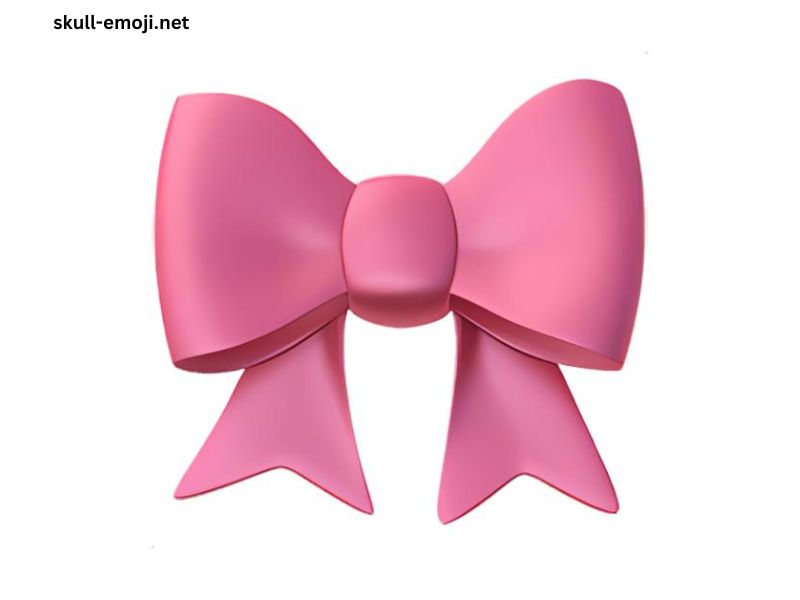In the digital age, emojis have become a universal language, transcending barriers of culture and language. Among these playful symbols, the bow emoji (🎀) stands out as a versatile and charming character. This article will explore the significance, uses, history, and the practical aspects of copying and pasting the bow emoji, helping you understand why it has gained popularity in digital communication.
What is the Bow Emoji?
The bow emoji depicts a ribbon, typically in a vibrant pink or red color, tied into a bow shape. It symbolizes various concepts, including gifts, celebrations, and feminine elegance. Used in texts, social media posts, and emails, it adds a touch of flair and emotion to messages, often conveying feelings of joy, affection, or festivity.
Unicode Representation
The bow emoji is officially represented in the Unicode Standard as U+1F380. It falls under the “Objects” category, which includes various symbols and objects. Unicode is the universal character encoding standard that allows text and symbols to be represented consistently across different platforms and devices.
The Cultural Significance of the Bow Emoji
Emojis often reflect cultural elements, and the bow emoji is no exception. It embodies themes of gift-giving, celebration, and even fashion. Here are a few cultural contexts in which the bow emoji is often used:
1. Gift-Giving and Celebrations
The bow is commonly associated with wrapped gifts. Thus, the bow emoji frequently appears in conversations about birthdays, holidays, and special occasions. People might use it to express excitement about receiving a present or to celebrate someone’s special day.
2. Feminine Symbolism
The bow has historically been linked to femininity, often used in fashion and design. The bow emoji is often employed in discussions about beauty, style, and women’s empowerment, serving as a playful representation of feminine aesthetics.
3. Cute and Playful Expressions
The bow emoji adds a playful touch to messages. It’s often used in lighthearted conversations, as a way to convey friendliness and warmth. Whether you’re talking about pets, cute outfits, or delightful experiences, the bow emoji enhances the playful tone.
How to Use the Bow Emoji
1. Text Messaging and Social Media
In text messaging, the bow emoji can convey excitement or happiness. For example, after receiving a surprise gift, you might text, “I can’t believe you got me this! 🎀” On social media platforms like Instagram or Twitter, it can be paired with captions that celebrate achievements, special moments, or simply add flair to a photo.
2. Invitations and Announcements
When sending out invitations for a party or event, incorporating the bow emoji can add a festive touch. For instance, “Join us for a birthday bash! 🎉🎀” captures the celebratory mood and enhances the visual appeal of the message.
3. Creative Uses in Art and Design
Digital artists and designers often incorporate the bow emoji into their works to add a whimsical or decorative element. It can be featured in graphics, branding materials, and social media content, providing a cheerful accent.
Copying and Pasting the Bow Emoji
Now that we’ve explored the significance of the bow emoji, let’s delve into the practicalities of copying and pasting it across different platforms. This section will guide you through the steps to easily incorporate the bow emoji into your digital communication.
1. Copying the Bow Emoji
To copy the bow emoji (🎀), follow these simple steps:
- Desktop (Windows/Mac):
- Highlight the bow emoji (🎀) with your cursor.
- Right-click and select “Copy,” or press
Ctrl + C(Windows) orCommand + C(Mac) on your keyboard.
- Mobile (iOS/Android):
- Long-press the bow emoji (🎀) until options appear.
- Select “Copy” from the menu that appears.
2. Pasting the Bow Emoji
Once you’ve copied the bow emoji, it’s easy to paste it wherever you want:
- Desktop:
- Navigate to the text box or area where you want to paste the emoji.
- Right-click and select “Paste,” or press
Ctrl + V(Windows) orCommand + V(Mac).
- Mobile:
- Tap and hold in the text area until the paste option appears.
- Select “Paste” from the menu.
3. Using Emoji Keyboards
Many devices have built-in emoji keyboards that allow you to easily access a wide range of emojis, including the bow emoji. Here’s how to use them:
- On Mobile:
- Open your messaging app and tap the emoji icon on your keyboard.
- Search for “bow” or scroll through the available emojis until you find it. Tap to insert.
- On Desktop:
- On Windows, you can access the emoji keyboard by pressing
Windows Key + .(period). - On Mac, press
Control + Command + Spaceto open the emoji viewer, then search or browse for the bow emoji.
- On Windows, you can access the emoji keyboard by pressing
The Evolution of Emojis
To fully appreciate the bow emoji, it’s helpful to understand the evolution of emojis as a whole. Emojis originated in Japan in the late 1990s and quickly spread globally. Their popularity soared with the rise of smartphones, leading to the development of vast emoji libraries.
1. From Simple to Complex
Initially, emojis were simple characters representing basic emotions or objects. Over time, they evolved into complex designs, encompassing a broader range of expressions, activities, and cultural references. Today, there are thousands of emojis, including diverse representations of people, animals, and objects.
2. The Role of Unicode
The Unicode Consortium plays a crucial role in the emoji landscape. It standardizes emoji characters, ensuring they are universally recognizable across different devices and platforms. This standardization is vital for effective communication in our interconnected world.
The Impact of Emojis on Communication
Emojis, including the bow emoji, have transformed the way we communicate. Here’s how:
1. Enhancing Emotional Expression
Emojis serve as visual cues that enhance the emotional tone of messages. A text that might seem neutral can take on a joyful or playful tone with the addition of a bow emoji. This helps to convey feelings that might be lost in plain text.
2. Bridging Language Barriers
Emojis can transcend language barriers, allowing people from different linguistic backgrounds to communicate more effectively. The bow emoji can convey joy or celebration without the need for words, making it a powerful tool in global communication.
3. Encouraging Creativity
Emojis inspire creativity in digital expression. Users often combine emojis in unique ways to tell stories or create visual art. The bow emoji, when paired with other emojis, can evoke a variety of themes and messages, showcasing the creativity of the user.
Conclusion
The bow emoji (🎀) is more than just a cute digital symbol; it represents a rich tapestry of emotions, cultural significance, and digital communication. Its versatility allows it to fit into various contexts, from celebrations to expressions of affection. Understanding how to copy and paste the bow emoji can enhance your digital conversations, adding a touch of charm and playfulness.
As we continue to navigate the ever-evolving landscape of digital communication, emojis like the bow will remain vital in enriching our interactions, making them more expressive, inclusive, and engaging. So go ahead—add a little flair to your messages with the bow emoji and celebrate the joy of digital expression!



